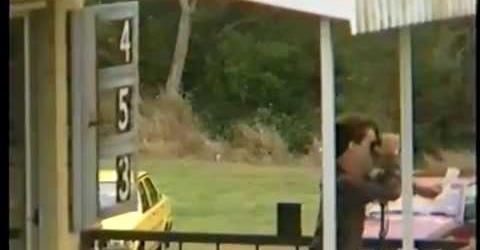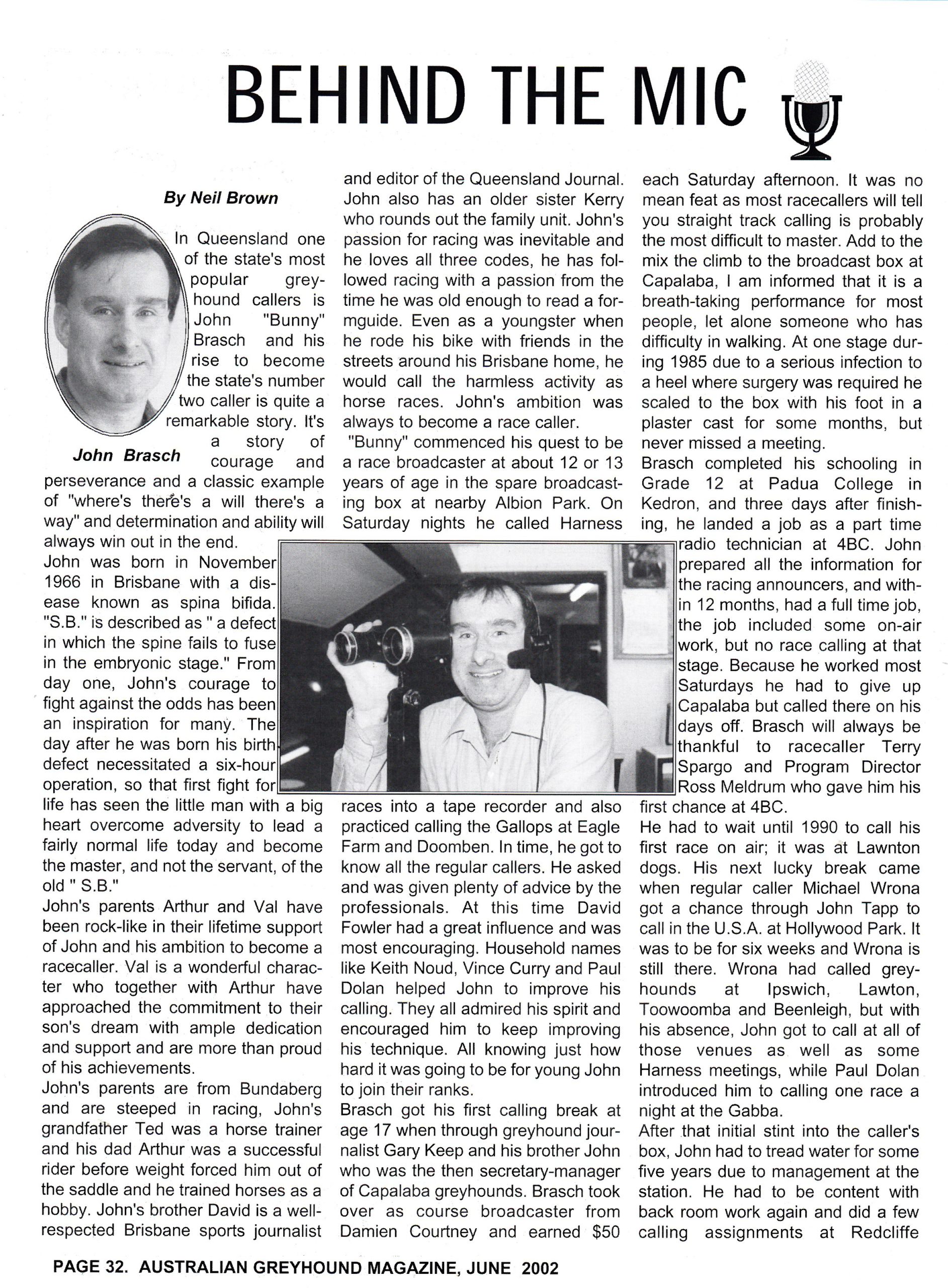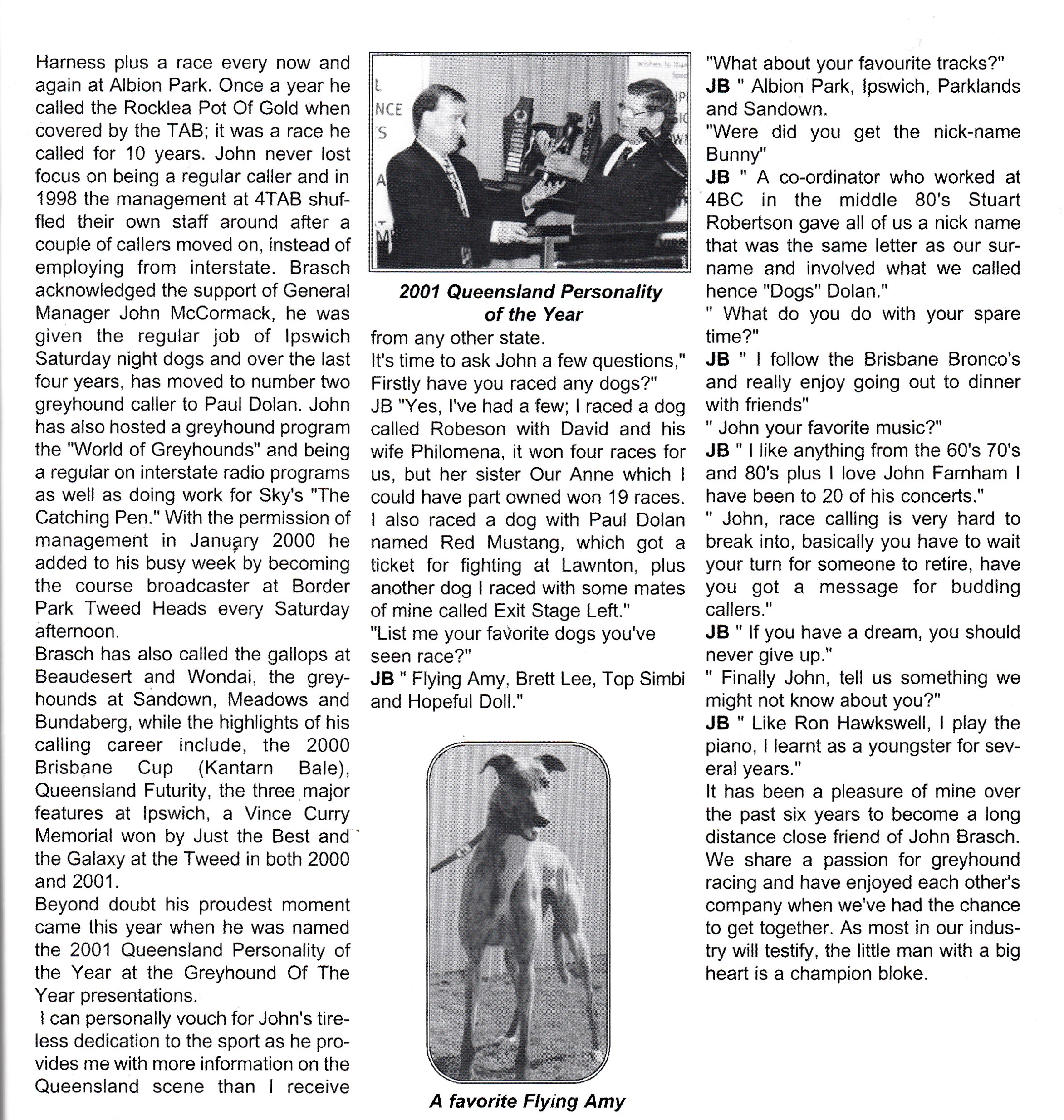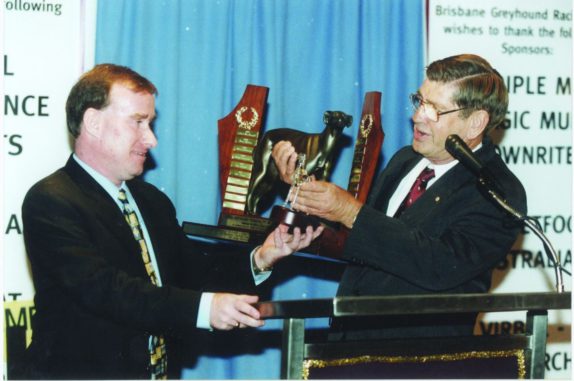
Another great Queenslander my good friend John Brasch receiving the Media Personality of the Year award. Below is a story from Keith Noud Recalls published in 1986. Keith dedicated the last chapter of his book John “Bunny” Brasch. It highlights John’s amazing story of determination and courage to make it and become the number one Greyhound caller in Queensland. I have also added a story I did with John in 2002 from my magazine. After 29 years John and I still remain the best of long distance friends I have tipped on Sandown with John on Queensland Radio for the last three or four years every Thursday. I miss his late parents Arthur and Val who were as nicer people as I have ever had the privilege to spent time with. In all the time I have known John his passion for race calling has never changed. The little man as he has always been is a champion bloke.
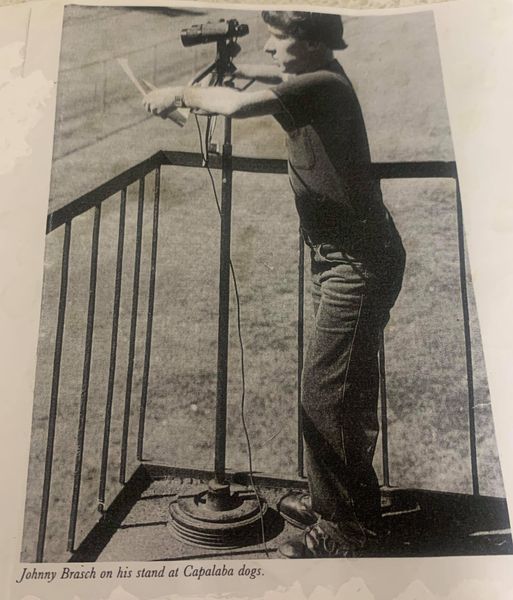
Little Man With A Big Heart – By Keith Noud
This is the story of a Brisbane teenager whose intrepid will to win — plus a rare love of horses — transformed him from a victim of a terrifying complaint (or disease if you like) to a stage where he has become the only race caller of his kind in Australia, and perhaps the Western World.
He is John Brasch, who was born on November 25, 1966, with spina bifida.
You may have read of “S.B.” in newspapers, heard it garbled in conversations, and wondered at its implications. Even John’s parents Arthur and Val Brasch had difficulty in pronouncing the two grim words, much less understanding what it was all about. Collins’ Australian Pocket Dictionary describes spina bifida thus: “A defect in which the spine fails to fuse in the embryonic stage.”
To me that means a wanton wrecker of the human body, a vicious attack on the human spirit, and a Herculean effort for survival.
From the moment he was born, John Brasch learnt to fight — firstly for life and later for the rudiments of learning. The day after he came into this life the way was cleared for battle; his birth defect necessitated a six-hour operation.
But the legacies inherited from spina bifida were strongly contested by a cocoon of love and affection woven by his closely knit racing family who have never wavered in their resolve to encourage John to fight back.
And this little man, whose height is less than five feet and who weighs about 47kg, didn’t falter either; so much so that today he leads a fairly normal life, although in the final analysis it has been his strong character which has set an example for others, particularly those whose lives have been dimmed by ill-health.
He battled his way through school to Grade 12 (the old senior level), in which he had a satisfactory score.
His grandfather, Edward Brasch, trained thoroughbreds with success in the Bundaberg area, and his father, Arthur Brasch, was a winner as a jockey until weight forced him out of the saddle, then to become a successful hobby trainer.
From the time he could walk, which has been with some difficulty, John Brasch has been a regular at Brisbane race meetings. He’s an avid but small punter, betting from the time he could read a form guide.
His mother Val Brasch is a wonderful character, with lots of good sense. She queried the point (to herself) whether it was correct to pick John up after school at Padua College, Kedron, and then rush him to either Eagle Farm or Doomben to see the final two races. She weighed the contingencies.
and decided that, in the circumstances, her young son with the small body and big heart should go racing. So John got to the races armed with his tape-recorder and form guide, and still in his school clothes.
The years were passing, and John had to decide on what he had to do to make his contribution to society. He thought of sporting journalism but he kept returning to what was his first love — race calling. I remember seeing him at Albion Park, when he told me of his ambition. To my mind I didn’t tell him that I thought the fortunes of life had been loaded against him so far as that avenue was concerned. But to my everlasting discredit I thought to myself that his chances of success were about a million to one. How wrong I was!
Meanwhile, Johnny Brasch kept on stoking the hot coals of his ambition. Every Wednesday and Saturday night he was at Albion Park harness race meeting practising his race calling.
He taped his own calls and later, through the then Albion Park general manager Milton Hulbert, he was able to extend his hobby by using one of the boxes in the new $15 million complex.
Little did Johnny Brasch realise at the time (he was then aged 17) that he was moving closer to the realisation of his dream of becoming a member of the “They’re racing!” clan. He had become acquainted with many members of the sporting media, and this helped him into a position of calling at the Capalaba greyhound meetings.
Capalaba is a straight track. Here I might mention my own experience of calling horses up the six-furlong straight at Doomben back in the 1930s. (The straight track was laid for racing from 1933, but closed in 1942 when war flared in the Pacific; Doomben was taken over for accommodation of Allied troops, particularly those from the U.S.) In my 45 years of calling, the most difficult part of the job was spotting them “up the straight”. I did not know which certainty, who was in front. And when I found a leader I never knew how far he, or she, was in front.
So imagine the feelings of this teenage broadcaster of the ’80s, calling for the first time a series of charging greyhounds on a straight track. Races are run over 366 meters and, I am informed, it is virtually impossible to pick leaders, even with strong binoculars, in the early and middle stages.
But Johnny Brasch never gave up. He kept on “calling ’em”, and now is regarded as a positive and accurate broadcaster.
Through John, I became aware of young 4BC race broadcaster Terry Spargo, John recently joined the staff of that radio station and has shown exceptional promise in a series of race details.
From his fee he contributed $10 a week to the upkeep of a young greyhound he had in tow with partnership with his sister-in-law Philomena, who is married to sporting journalist David Brasch. I’m told that the dog will develop into a champion.
John faced a crisis in mid-1985, when a small cut on his heel, sustained some years before, suddenly blew into a boil the size of an orange. Surgery was necessary; and the healing process (which involved skin grafting) did not clear up the foot for some time.
The climb to the broadcaster’s box at Capalaba is a breath-taking performance for most people, let alone someone who has difficulty in walking.
For John Brasch it probably looks like Mt. Everest. He has to wear special boots and special trousers in normal circumstances, and he walks with an unusual gait.
But what he has in abundance is “guts”. Each Saturday for months, with one foot heavily encased in a plaster cast, he made that awesome climb to call the dogs at Capalaba.
And he didn’t miss a meeting!
Proof, beyond doubt, that young “J. B.” had become the master, and not the servant, of old “S. B.”
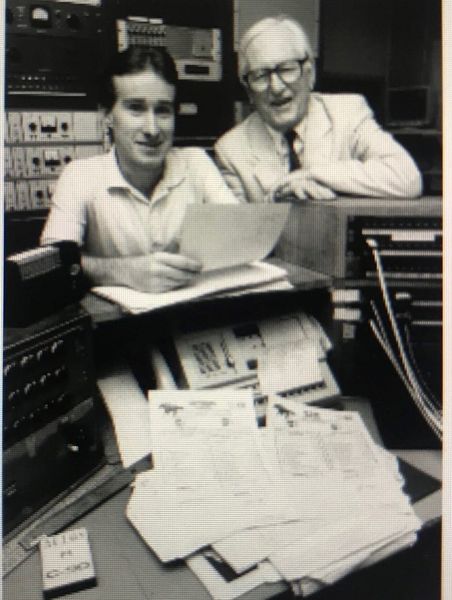
John aged 20 with Keith Noud and in the Box at Capalaba.
